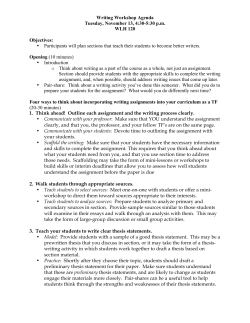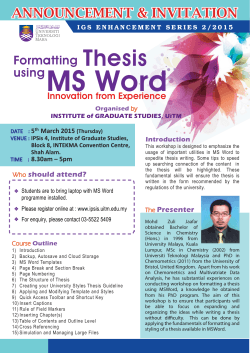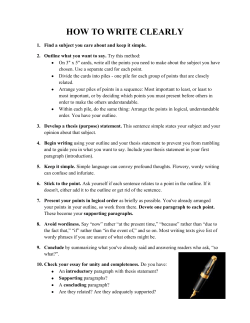
CHAPTER 5 CONCLUSION AND SUGGESTIONS
CHAPTER 5 CONCLUSION AND SUGGESTIONS This chapter describes the conclusion of what have previously been discussed and some suggestions regarding this study. 5.1 Conclusion The competency to write a good academic writing is very important for students. During their study periods, students have to make many writings. Students have to write to do their assignments and their exams during their study period. Then, in their last year they have to write a thesis as partial fulfillment of the requirements for their degree. So far, however, there has been little discussion about academic writing, especially thesis conclusion, so the writer decided to conduct research on students’ thesis conclusions. The purposes of the current study are to investigate the structures of undergraduate students’ thesis conclusions and to investigate the lexical phrases of undergraduate students’ thesis conclusions. There are two research questions in this study. They are: (a) What are the structures of undergraduate students’ thesis conclusions? (b) What are the lexical phrases of undergraduate students’ thesis conclusions? This study uses descriptive qualitative research approach. In this investigation, the writer used documents as the data, so this investigation is a documentary study. In this study, the writer used the document files, 20 undergraduate English Department academic year 2006 students’ thesis 156 conclusions. This study is dealing with text analysis particularly discourse analysis. The instrument of this study is the writer herself and the tool of this study is a template of Typical Structure by Bunton (Bunton, 2005 in Paltridge & Starfield, 2007). The writer analyzed the data based on the template. The most obvious finding emerging from this study is that there are 16 types of structures found in the students’ thesis conclusions and there is no thesis conclusion of the students which exactly matched the Bunton template of thesis conclusion structure (Bunton, 2005 in Paltridge & Starfield, 2007). Those 16 types of structures can be classified into three major types of structures. They are (a) I-C-R (Introductory statement-Consolidation of the research spaceRecommendations and implications) (b) I-C-I-R (Introductory statementConsolidation of the research space-Introductory statement-Recommendations and implications) (c) C-I-R (Consolidation of the research space-Introductory statement-Recommendations and implications). The most common type from the 20 undergraduate English Department academic year 2006 students’ thesis conclusions is I-C-R (Introductory statement-Consolidation of the research spaceRecommendations and implications) which has 14 variations. The other two types of structures have no variation. In addition, from the 20 undergraduate English Department academic year 2006 students’ thesis conclusions, 19 thesis conclusions have incomplete subsections based on Bunton template and only one thesis conclusion has complete subsections based on Bunton template. It is Data 17. 157 Moreover, the missing subsections in the 20 undergraduate English Department academic year 2006 students’ thesis conclusions are mostly Research Questions or hypotheses (RQ). Research Questions or hypotheses (RQ) may be considered as important parts in thesis conclusions. If the Research Questions or hypotheses (RQ) are not stated in the thesis conclusion, the readers may be unable to understand what the Research Questions or hypotheses (RQ) in the thesis exactly are. In consequences, the missing of Research Questions or hypotheses (RQ) gives significant impacts to the readers in gaining information from the thesis conclusions. Furthermore, this study finds that generally there are some lexical phrases which are often used by the undergraduate students of English Department Widya Mandala Catholic University. Many variations of lexical phrases are used to express the subsections in each section of students’ thesis conclusions. All lexical phrases are appropriate to the functions. 5.2 Suggestions 5.2.1 For Future Research The writer would like to suggest other researchers to conduct further studies on this topic. Future research may investigate the same topic, but with different data, for example: future researcher might investigate the undergraduate English Department year 2007 students’ thesis conclusions, so that the result will be more valid. In addition, it will be interesting to compare the undergraduate students’ thesis conclusions and the graduate students’ thesis conclusions in terms 158 of the structures and the languages or lexical phrases. Moreover, further investigation into other part of thesis, such as Discussion is strongly recommended. 5.2.2 For Practical Implications The findings of this study have a number of important implications for future practice, for the lecturers and for the thesis advisors of Widya Mandala Catholic University Undergraduate School a. For the lecturers The evidence from this study suggests that the lecturers should teach how to write a thesis conclusion and give more references about writing thesis conclusion because there is no thesis conclusion of the students which exactly matched the Bunton template of thesis conclusion structure. b. For thesis advisors of Widya Mandala Catholic University The results of this research support the idea that the thesis advisors should give some advice to the advisees in making their thesis conclusions. So, students’ thesis conclusions might have sufficient information needed and the thesis conclusions could be constructed in the logical way. 5.2.3 Limitation of the Study The current investigation is limited by time, so the writer did not go deeper in the discussion of languages of students’ thesis conclusions. The writer suggests next researchers to go deeper in the discussion of languages of students’ thesis conclusions when they conduct research on the same topic. 159 BIBLIOGRAPHY Bunton, D. (2005). The structure of PhD conclusion chapters. Journal of English for Academic Purposes (4): 207–224. Retrieved 19 January 2012 from http://www.cs.ucl.ac.uk/staff/M.Sewell/faq/publishingresearch/Bunt05.pdf Bryman, A. (n.d.). Triangulation. Retrieved 23 May 2011 from http://referenceworld.com/sage/socialscience/triangulation.pdf Dahl, T. (2004). Textual metadiscourse in research article: A marker of national culture or of academic discipline? Journal of Pragmatics, 36, 1807-1825. Dewi, C. S. A. (2009). Types and Structures of Thesis Abstracts Written by the English Department Students of Widya Mandala Catholic University. Widya Mandala Catholic University, Surabaya. Dunleavy, P. (2003). Authoring a PhD: How to plan, draft, write, and finish a doctoral thesis or dissertation. Hampshire: Palgrave MacMillan. Evan, D. & Grupa, P. (2002). How to write a better thesis. Melbourne: University Press. Heigham, J. & Croker, R. A. (Eds.). (2009). Qualitative research in applied linguistics: A practical introduction. New York: Palgrave Macmillan. Helicon Publishing. (2011). Generic structure. Retrieved 17 May 2011 from http://www.talktalk.co.uk/reference/encyclopaedia/hutchinson/m0097270.ht ml Li, J. & Schmitt, N. (2009). The acquisition of lexical phrases in academic writing: a longitudinal case study. Journal of Second Language Writing (18): 85-102. Retrieved 19 January 2012 from http://www.sciencedirect.com/science/article/pii/S1060374309000034 MacMillan, J. H. (2008). Educational research: Fundamentals for the consumer (5th ed.). Boston: Pearson Education. 160 Murray, R. (2005). Writing for academic journals. England: Open University Press. Nattinger, J. R. & DeCarrico, J. S. (1992). Lexical Phrases and Language Teaching. Oxford: Oxford University Press. Paltridge, B. & Starfield, S. (2007). Thesis and dissertation writing in a second language. New York: GreenGate. Prior, P. (1998). Writing /disciplinarity. New Jersey: Lawrence Erlbaum. Shaw, P. (1991). Science research students’ composing processes. English for Specific Purposes, 10, 189-206. Shuttleworth, M. (2008). Descriptive research design. Retrieved 25 December 2011 from http://www.experiment-resources.com/descriptive-research-design.html Stephanie, L. (2008). the rhetorical patterns of argumentative compositions of the English department students of Widya Mandala Catholic University Surabaya. Magister, 25, 48-82. Tardy, C. M. (2005). It’s like a story: Rhetorical knowledge development in advanced academic literacy. Journal of English for Academic Purposes, 4, 324-338. Thompson, P. (2005). Points of focus and position: Intertextual references in PhD theses. Journal of English for Academic Purposes, 4, 307-323. Weissberg, R. & Buker, S. (1990). Writing Up Research: Experimental Research Report Writing for students of English. New Jersey: Prentice-Hall.
© Copyright 2025









